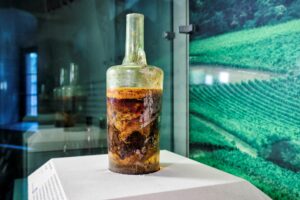Biography
WHAT WAS ONCE THE OLDEST WINE
THE SPEYER WINE BOTTLE: PAST AND PRESENT
Dr. Sebastian Zanke
Historisches Museum der Pfalz
(Historical museum of the Palatinate, Germany)
In 1867, two Roman graves from the 4rd century were discovered in Speyer. Several well-preserved bottles were unearthed in the two graves, one of which was to become known as the oldest wine bottle still containing liquid wine – at least until 2024. However, the importance of the bottle is outweighed by the many unanswered questions about its contents and history.
The so-called Roman wine or Roman wine bottle has become a monument to the cultural history of the Palatinate in the last century, a region that draws heavily on its history as a wine region for its local heritage and identity. On this ground, the paper discusses the history of the Roman wine bottle as an archaeological and cultural object.
It draws a line from its discovery and early – and only – scientific examination to its history as a cultural monument in modern times, discussing both the archaeological object and the importance (and construction) of myth and tradition for the cultural heritage of a wine region.
EL VINO MÁS ANTIGUO
LA BOTELLA DE VINO SPEYER: PASADO Y PRESENTE
Dr. Sebastian Zanke
Museo Histórico del Palatinado (Alemania)
En 1867 se descubrieron en Espira dos tumbas romanas del siglo IV. En ellas se desenterraron varias botellas bien conservadas, una de las cuales se convertiría en la botella de vino más antigua que aún contenía vino líquido, al menos hasta 2024. Sin embargo, la importancia de la botella se ve superada por las muchas preguntas sin respuesta sobre su contenido y su historia.
El llamado vino romano o botella de vino romana se ha convertido en el último siglo en un monumento a la historia cultural del Palatinado, una región que se basa en gran medida en su historia como región vinícola para su patrimonio e identidad locales. Sobre esta base, el artículo analiza la historia de la botella de vino romana como objeto arqueológico y cultural.
Traza una línea desde su descubrimiento y su temprano -y único- examen científico hasta su historia como monumento cultural en los tiempos modernos, discutiendo tanto el objeto arqueológico como la importancia (y la construcción) del mito y la tradición para el patrimonio cultural de una región vinícola.



